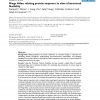27 search results - page 4 / 6 » Impact of residue accessible surface area on the prediction ... |
BMCBI
2007
13 years 7 months ago
2007
Background: Predicting protein residue-residue contacts is an important 2D prediction task. It is useful for ab initio structure prediction and understanding protein folding. In s...
BIOINFORMATICS
2007
13 years 7 months ago
2007
Motivation: Protein–protein complexes are known to play key roles in many cellular processes. However, they are often not accessible to experimental study because of their low s...
BMCBI
2007
13 years 7 months ago
2007
Background: Relating features of protein sequences to structural hinges is important for identifying domain boundaries, understanding structure-function relationships, and designi...
BMCBI
2007
13 years 7 months ago
2007
Background: Recognition of binding sites in proteins is a direct computational approach to the characterization of proteins in terms of biological and biochemical function. Residu...
RECOMB
2001
Springer
14 years 7 months ago
2001
Springer
A method is presented that uses b-strand interactions to predict the parallel right-handed b-helix super-secondary structural motif in protein sequences. A program called BetaWrap...

